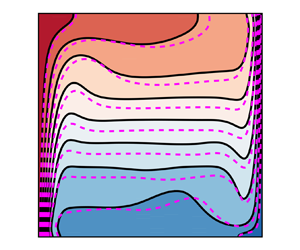Article contents
Perturbation analysis of baroclinic torque in low-Mach-number flows
Published online by Cambridge University Press: 03 November 2021
Abstract

In this paper, we propose a series expansion of the baroclinic torque in low-Mach-number flows, so that the accuracy and universality of any buoyancy term could be examined analytically, and new types of buoyancy terms could be constructed and validated. We first demonstrate that the purpose of introducing a buoyancy term is to approximate the baroclinic torque, and straightforwardly the error of any buoyancy term could be defined with the deviation of its curl from the corresponding baroclinic torque. Then a regular perturbation method is introduced for the elliptic equation of the hydrodynamic pressure in low-Mach-number flows, resulting in a sequence of Poisson equations, whose solutions lead to the series representation of the baroclinic torque and the new types of buoyancy terms. It is found that the frame invariance of the momentum equation is maintained with one of the new types of buoyancy terms. With the error definition of buoyancy terms and the series representation of the baroclinic torque, the validity and accuracy of previous and new buoyancy terms are examined. Finally, numerical simulations confirm that, with a decreasing density variation or an increasing order of our new buoyancy term, the simplified equations can converge to the original low-Mach-number equations.
JFM classification
Information
- Type
- JFM Papers
- Information
- Copyright
- © The Author(s), 2021. Published by Cambridge University Press
References
REFERENCES
- 1
- Cited by


